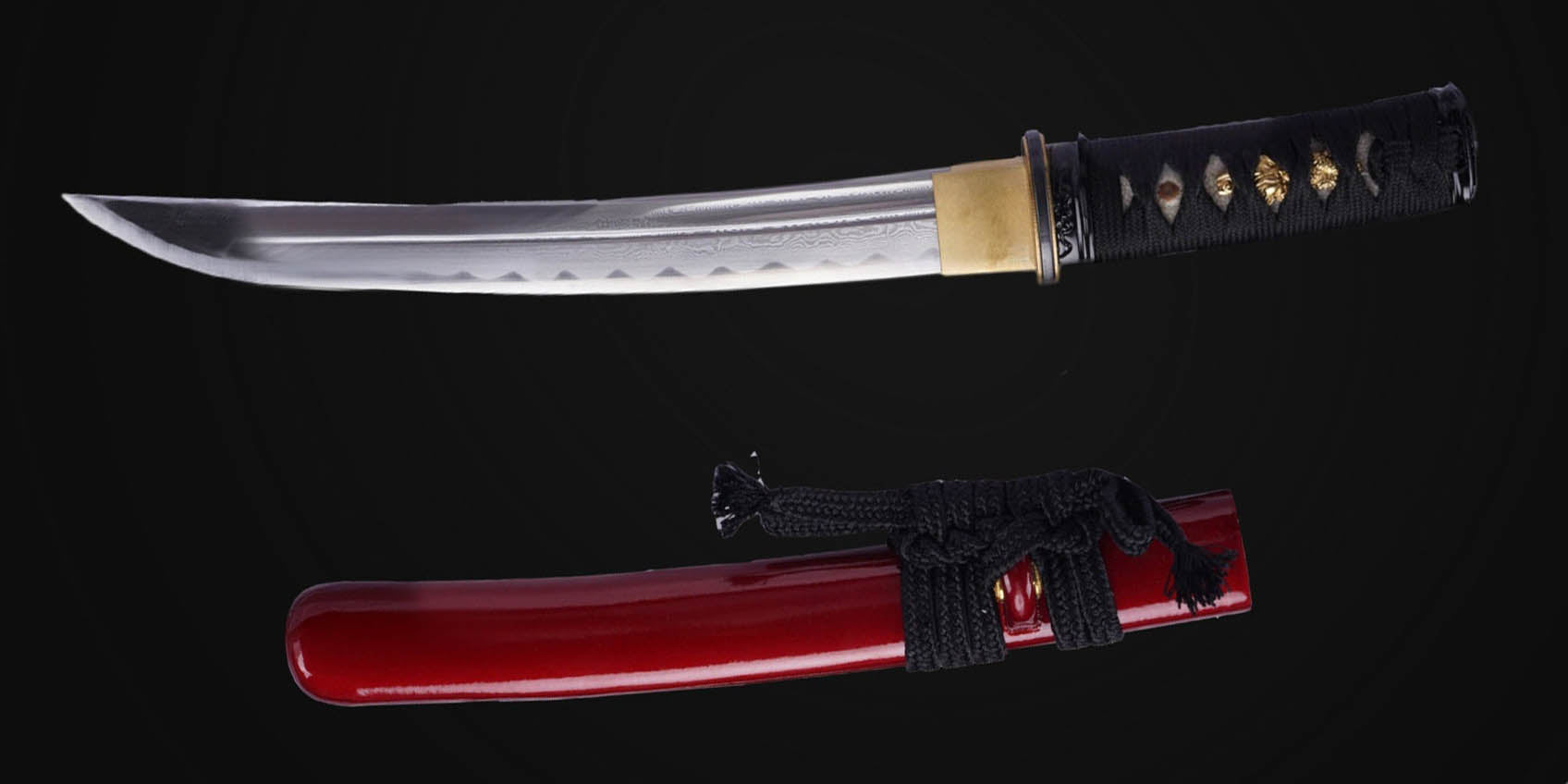The Tanto Sword: A Masterpiece of Precision and Tradition

Tanto Japanese: The Tanto Sword – A Masterpiece of Precision and Tradition
The tanto sword is a smaller yet highly significant weapon in Japanese swordmaking, renowned for its precision and craftsmanship. Typically measuring between 6 to 12 inches in blade length, the tanto is characterized by its sharp, single-edged blade, designed for close combat and self-defense. Its compact size allows for swift, precise strikes, making it an essential tool for samurai, especially in situations requiring quick, decisive action. The tanto has a deep cultural significance, representing both the skill of the Japanese swordsmith and the samurai's ability to adapt to any situation. Despite its size, the tanto is considered a masterpiece of Japanese sword tradition, blending artistry and functionality.
Parts of the Katana: Understanding the Tanto Sword
The Tanto sword is a symbol of precision and tradition, with each part of the blade carefully crafted to ensure both functionality and beauty. The sword blade itself is a masterpiece of craftsmanship, featuring a cutting edge that is razor-sharp, ideal for close combat or ceremonial use. The habaki (blade collar) plays an essential role in holding the blade securely in the tsuka handle, preventing any unwanted movement.
The tsuka ito (handle wrap) is traditionally made from silk, cotton, or leather, offering a comfortable yet firm grip for the user. Beneath the wrap, the tsuka handle is often reinforced with buffalo horn for added strength and durability. The katana scabbard protects the blade when not in use, and the habaki also ensures that the blade fits tightly within the scabbard, preventing it from rattling or shifting.
Each component of the Tanto sword is crafted with great attention to detail, reflecting both the warrior’s spirit and the swordsmith's skill. Whether for use in battle or as a collector's item, the Tanto sword stands as a testament to Japan's rich swordmaking heritage.
Japanese culture is renowned for its attention to detail and craftsmanship, and this is evident in many aspects of their art and history. One such aspect is the Japanese Tanto blade, a miniature masterpiece that exemplifies the precision and artistry of Japanese swordsmiths. In this blog, we will explore the world of the Tanto blade, its history, significance, and the meticulous craftsmanship that goes into creating these exquisite blades.
1. The Tanto Blade: A Brief History
The Tanto is a traditional Japanese dagger with a blade that typically ranges from 6 to 12 inches in length. The history of Japanese Tanto Blade can be traced back to the Heian period (794-1185), making it an integral part of Japanese culture for over a millennium. Initially, it was used as a secondary weapon by samurai, complementing their primary swords (katana or wakizashi). Over time, the Tanto evolved from being a utilitarian tool to a symbol of status and a work of art.
2. Symbolism and Significance
Tanto blades are not just functional weapons; they are imbued with deep symbolism and cultural significance. They often serve as a reflection of the owner's personality and beliefs. Tanto blades can be categorized into different styles, each with its unique design elements and symbolism. Some of the common styles include the Koshirae Tanto, Aikuchi Tanto, and Yanone Tanto. These different styles convey messages of elegance, simplicity, or strength.
The Tanto also played a crucial role in the Japanese code of honor, known as Bushido. Samurai regarded their Tanto blades as a symbol of their integrity, as they were used in acts of ritual suicide, known as seppuku, when they failed to uphold their honor. This practice highlights the spiritual and ethical importance of the Tanto in Japanese culture.
3. The Craftsmanship Behind Tanto Blades
Creating a Tanto blade is a labor-intensive process that demands exceptional craftsmanship. Japanese swordsmiths, also known as 'Tosho,' employ traditional techniques that have been passed down through generations. The quality of the steel, forging, and the meticulous attention to detail are the hallmarks of Tanto craftsmanship.
The blade is often made from high-carbon steel, which is meticulously folded and hammered hundreds of times to remove impurities and create a strong, sharp edge. The unique shape of the Tanto blade requires precision grinding and polishing to achieve its distinct, graceful curve. The Hamon, a visible line created during the hardening process, is a signature feature of Japanese swords, including Tanto blades, and adds to their beauty.
4. Collecting and Appreciating Tanto Blades
Tanto blades have gained worldwide recognition for their artistic value and craftsmanship. Collectors and enthusiasts often search for antique Tanto blades, and these can be highly sought after. However, it's essential to ensure that you are purchasing from reputable sources, as there are many replicas on the market.
To truly appreciate the art of the Tanto blade, one should consider its historical context, symbolism, and the skill that went into creating it. Museums and exhibitions often feature Tanto blades as part of their Japanese sword collections, allowing visitors to admire their beauty and learn about the history and culture that surrounds them.
In conclusion, the Japanese Tanto blade is not merely a weapon; it is a testament to the exquisite craftsmanship and artistic sensibility that define Japanese culture. Its rich history, symbolism, and meticulous craftsmanship make it a miniature masterpiece that continues to captivate people worldwide. Whether you are a collector, a historian, or simply an admirer of fine art, the Tanto blade is an embodiment of Japanese artistry and heritage that is truly worthy of exploration and appreciation.
The Tanto Sword: Versatility and Elegance in Feudal Japan
The Tanto sword, with its single-edged design and compact size, is a versatile weapon that embodies the artistry and practicality of feudal Japan. Unlike the long sword such as the katana, the Tanto was crafted for close-quarters combat, making it an indispensable tool for samurai in situations where agility and precision were paramount. Its short blade, typically measuring between 6 to 12 inches in blade length, was ideal for swift, decisive movements, offering both offense and defense in tight spaces.
Tanto in Traditional Martial Arts
In traditional martial arts, the Tanto continues to hold a special place. Martial artists use custom Tanto blades for training, emphasizing the weapon's balance and control. Techniques involving the Tanto focus on precise strikes and defensive maneuvers, mirroring its historical use in hand-to-hand combat.
Design and Material Excellence
A hallmark of the Tanto knife is the meticulous attention to detail in its construction. The ray skin handle wrapping not only enhances grip but also adds a layer of elegance to the weapon. The high-quality steel used in crafting Tanto blades ensures their durability and sharpness, making them exceptional examples of edged blades. The combination of practicality and beauty in the Tanto design reflects the samurai's balance of warrior spirit and aesthetic appreciation.
Modern Custom Tanto and Collecting
Today, custom Tanto knives and swords have become highly sought-after collectibles. Modern interpretations maintain the integrity of the traditional Tanto while incorporating contemporary materials and techniques. Enthusiasts often choose bespoke designs, appreciating the adaptability of the Tanto for both combat and artistic purposes.
The Legacy of the Tanto
The Tanto sword is not merely a relic of the past; it is a living testament to the ingenuity and artistry of Japanese swordsmiths. From its role in feudal Japan to its enduring presence in traditional martial arts, the Tanto remains a symbol of precision, resilience, and cultural heritage.
Whether as a weapon, a collector's item, or a piece of history, the Tanto sword continues to captivate those who value the seamless blend of form and function in Japanese craftsmanship.
The Blade Geometry of the Tanto: Precision in Design
A distinctive feature of the Tanto blade lies in its blade geometry, which showcases the meticulous engineering and artistry inherent in Japanese swordsmithing. Unlike double-edged daggers, the Tanto is a single-edged blade, offering both structural integrity and focused cutting performance. Its geometry is specifically designed to maximize utility, elegance, and strength, making it a versatile tool and weapon.
The Unique Geometry of the Tanto Blade
The Tanto typically features a straight or slightly curved edge, with a sharply angled point known as a kissaki. This acute point design, combined with a thick spine, gives the blade exceptional piercing capability. The edge geometry is often crafted with a convex grind, known as a "hamaguri-ba" (clam-shaped edge), which increases durability while maintaining sharpness. This type of grind prevents the edge from chipping during heavy use, making the Tanto suitable for cutting through armor or other tough materials in combat situations.
The Tanto’s spine, or mune, provides additional structural support. Some Tanto blades feature a spine that tapers slightly toward the tip, enhancing agility without compromising strength. The balance between the spine and the edge contributes to the Tanto's effectiveness in both slashing and stabbing motions.
Functional Advantages of the Single-Edged Design
The single-edged blade of the Tanto offers several advantages over double-edged designs. Firstly, the unsharpened back edge allows for safe handling and enables the wielder to place their thumb or palm against it for added control during precise movements. This makes the Tanto particularly effective in close-quarters combat, where control and accuracy are paramount.
Secondly, the single-edged geometry allows for more material to be concentrated toward the blade's spine, enhancing its resilience and making it less prone to breaking under stress. This design philosophy is a hallmark of Japanese swordsmithing, where functionality is harmonized with aesthetics.
Variations in Tanto Geometry
Different styles of Tanto blades showcase variations in geometry tailored to specific purposes. For instance, the Shobu-Zukuri Tanto features a continuous curve from the blade to the tip, emphasizing cutting efficiency. In contrast, the Hira-Zukuri Tanto, with its flat, triangular cross-section, provides a sleek and minimalist aesthetic while maintaining strength.
The tip geometry, often accentuated by the hamon line—a visual mark formed during the hardening process—further differentiates the Tanto from other blades. This line is not only decorative but also indicative of the blade’s functional zones, where the tip is hardened for sharpness, while the spine retains flexibility to absorb impact.
Modern Applications of Tanto Geometry
In modern times, Tanto blade geometry has been adapted for various uses beyond traditional combat. Tanto knives with reinforced tips are popular in tactical applications, such as law enforcement and outdoor survival, due to their ability to puncture and pry with ease. Additionally, the aesthetic appeal of the blade's geometry makes it a favored choice for collectors and custom knife makers who seek to blend traditional forms with contemporary materials and design elements.
In summary, the blade geometry of the Tanto is a defining characteristic that exemplifies the ingenuity of Japanese craftsmanship. Its single-edged design, robust tip, and carefully engineered grind make it a masterpiece of functional art, bridging the gap between practicality and elegance. Whether in historical or modern contexts, the Tanto's blade geometry continues to inspire admiration for its precision and timeless appeal.







